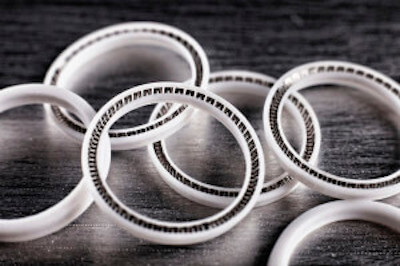Spring-energized seals are able to provide reliable, consistent sealing where other seals fail. The key to their performance lies in the additional sealing force made possible through a spring, but not all springs provide the same type of performance. In this blog post, we are going to talk about the four most common types of spring energizes: canted coil springs, cantilever springs, V springs, and helical springs.
Canted Coil Spring
Canted coil springs are wound at an angle to the axis along the length of the spring. They are able to maintain a very consistent force of over a wide deflection range, which contributes their popularity as a seal energizer. The load is primarily applied at the tip, which is excellent for sealing unless abrasive media is involved.In addition, these springs can be tailored to achieve specific forces. They are ideal for applications where friction needs to be minimized, including flap actuators and encoder and are often found in applications that involve dynamic rotary or reciprocating motion. Canted coil spring energizers work best for moderate to high speed rotary applications.
Cantilever Springs
Cantilever springs, also known as finger springs, have a v-shaped cross-section.These springs have a linear load curve (deflection and force as linearly related). Because of their shape, the load is concentrated at the very front of the seal which makes them a good choice for exclusion and scraping applications. Spring-energized seals with cantilever springs work well for low to medium speed applications and can be found on hydraulic cylinders, pumps, shocks, and compressors.
V Springs
The V spring, also called a V ribbon spring, is a general purpose energizing spring that provides good performance at a relatively low cost. which offers good performance at a relatively low cost. V spring energized seals are well adapted to severe applications, including vacuum pressures and cryogenic temperatures. These seals work well for applications that involve either rotary or reciprocating motion, but also perform well in static applications. In short, V spring energizers are ideal for general purpose applications.
Helical Spring
The helical springs, sometimes referred to as a helical wound spring, consists of a wound ribbon of metal that results in a relatively high load versus displacement curve, which also means their deflection range is quite small. Because of this, it can provide very tight, reliable sealing even in the presence of extreme pressures (including vacuum). Helical spring energized seals also work well for sealing in lightweight gases or liquids. However, they should be limited to either low speed, intermittently dynamic, or static applications where achieving a reliable seal is significantly more important than the effect of friction or the possibility of wear. Helical spring energizers are often used on pipe flanges and crush jackets where the seal jacket needs to be embedded into any surface irregularities.
Full Contact Spring
A Full Contact Spring provides a high-load, continuous spring contact along the entire circumference of the sealing lip. A full contact spring is recommended for extreme sealing conditions, such as those involving cryogenics, vacuum and/or light gases at low pressure. Because of its extreme chemical resistance and temperature applications, it is recommended for high-altitude aerospace and even space exploration missions.
Conclusion
If you are looking for a sealing solution involving an application where other seals have failed, spring-energized seals are an excellent option. Not only do you have flexibility in the choice of sealing jacket, you can also find spring energizers adapted to the particular challenges you are facing.



